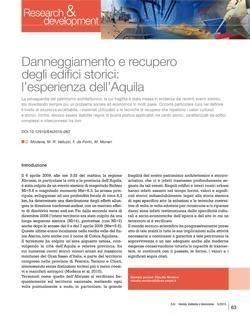La salvaguardia del patrimonio architettonico, la cui fragilità è stata messa in evidenza dai recenti eventi sismici, sta diventando sempre più un problema sociale ed economico in molti paesi. Occorre particolare cura nel definire il livello di sicurezza accettabile, i materiali utilizzabili e le tecniche di recupero che rispettino i valori culturali e storici. Inoltre, devono essere stabilite regole di buona pratica applicabili nei centri storici, caratterizzati da edifici complessi e interconnessi tra loro
Problems range from the same definition and choice of the “conventional” safety level, to the methodologies that can be used to perform reliable structural analyses and safety verifications (as modern ones are frequently not suitable for the construction under consideration) and to the selection, design and execution of appropriate materials and interventions techniques aimed to repair and strengthen the built heritage while preserving its cultural, historic, artistic values.
The earthquake that struck the Abruzzo region on 6th April 2009 at 3:32 a.m., had its epicentre in the capital of the region, L’Aquila, and seriously affected a wide area around the city, where many historic towns and villages are found. Lessons learned from this event gave relevant contributions to develop specific tools, to appropriately tackle the above mentioned problems, available to practitioner engineers and architects: methodology to intervene on complex and connected buildings in the historic centres, definition of adequate materials and techniques to intervene on the damaged buildings, codes and codes of practice specific for historic constructions.
A short review of all the mentioned aspects is presented in the paper, making specific reference to research activities, practical applications and to the recent evolution of codes and guidelines


